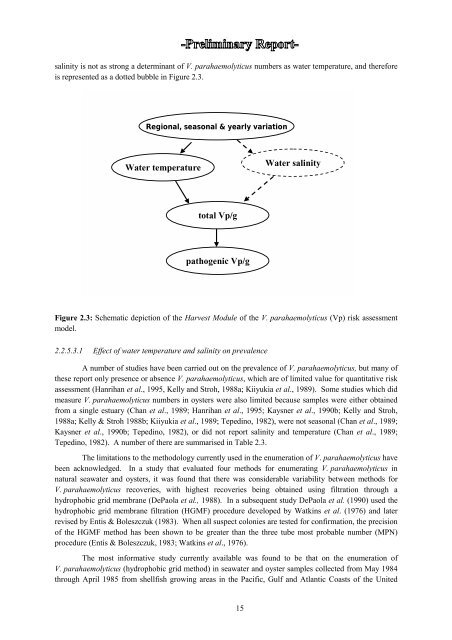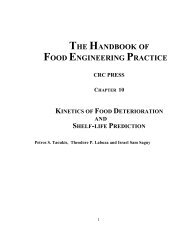Vibrio in seafood - FAO.org
Vibrio in seafood - FAO.org
Vibrio in seafood - FAO.org
You also want an ePaper? Increase the reach of your titles
YUMPU automatically turns print PDFs into web optimized ePapers that Google loves.
sal<strong>in</strong>ity is not as strong a determ<strong>in</strong>ant of V. parahaemolyticus numbers as water temperature, and thereforeis represented as a dotted bubble <strong>in</strong> Figure 2.3.Regional, seasonal & yearly variationWater temperatureWater sal<strong>in</strong>itytotal Vp/gpathogenic Vp/gFigure 2.3: Schematic depiction of the Harvest Module of the V. parahaemolyticus (Vp) risk assessmentmodel.2.2.5.3.1 Effect of water temperature and sal<strong>in</strong>ity on prevalenceA number of studies have been carried out on the prevalence of V. parahaemolyticus, but many ofthese report only presence or absence V. parahaemolyticus, which are of limited value for quantitative riskassessment (Hanrihan et al., 1995, Kelly and Stroh, 1988a; Kiiyukia et al., 1989). Some studies which didmeasure V. parahaemolyticus numbers <strong>in</strong> oysters were also limited because samples were either obta<strong>in</strong>edfrom a s<strong>in</strong>gle estuary (Chan et al., 1989; Hanrihan et al., 1995; Kaysner et al., 1990b; Kelly and Stroh,1988a; Kelly & Stroh 1988b; Kiiyukia et al., 1989; Teped<strong>in</strong>o, 1982), were not seasonal (Chan et al., 1989;Kaysner et al., 1990b; Teped<strong>in</strong>o, 1982), or did not report sal<strong>in</strong>ity and temperature (Chan et al., 1989;Teped<strong>in</strong>o, 1982). A number of there are summarised <strong>in</strong> Table 2.3.The limitations to the methodology currently used <strong>in</strong> the enumeration of V. parahaemolyticus havebeen acknowledged. In a study that evaluated four methods for enumerat<strong>in</strong>g V. parahaemolyticus <strong>in</strong>natural seawater and oysters, it was found that there was considerable variability between methods forV. parahaemolyticus recoveries, with highest recoveries be<strong>in</strong>g obta<strong>in</strong>ed us<strong>in</strong>g filtration through ahydrophobic grid membrane (DePaola et al., 1988). In a subsequent study DePaola et al. (1990) used thehydrophobic grid membrane filtration (HGMF) procedure developed by Watk<strong>in</strong>s et al. (1976) and laterrevised by Entis & Boleszczuk (1983). When all suspect colonies are tested for confirmation, the precisionof the HGMF method has been shown to be greater than the three tube most probable number (MPN)procedure (Entis & Boleszczuk, 1983; Watk<strong>in</strong>s et al., 1976).The most <strong>in</strong>formative study currently available was found to be that on the enumeration ofV. parahaemolyticus (hydrophobic grid method) <strong>in</strong> seawater and oyster samples collected from May 1984through April 1985 from shellfish grow<strong>in</strong>g areas <strong>in</strong> the Pacific, Gulf and Atlantic Coasts of the United15














